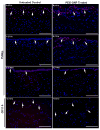Polyethylenimine-conjugated gold nanoparticles: Gene transfer potential and low toxicity in the cornea
- PMID: 21272669
- PMCID: PMC3094737
- DOI: 10.1016/j.nano.2011.01.006
Polyethylenimine-conjugated gold nanoparticles: Gene transfer potential and low toxicity in the cornea
Abstract
This study examined the gene transfer efficiency and toxicity of 2-kDa polyethylenimine conjugated to gold nanoparticles (PEI2-GNPs) in the human cornea in vitro and rabbit cornea in vivo. PEI2-GNPs with nitrogen-to-phosphorus ratios of up to 180 exhibited significant transgene delivery in the human cornea without altering the viability or phenotype of these cells. Similarly, PEI2-GNPs applied to corneal tissues collected after 12 hours, 72 hours, or 7 days exhibited appreciable gold uptake throughout the rabbit stroma with gradual clearance of GNPs over time. Transmission electron microscopy detected GNPs in the keratocytes and the extracellular matrix of the rabbit corneas. Additionally, slit-lamp biomicroscopy in live animals even 7 days after topical PEI2-GNP application to the cornea detected no inflammation, redness, or edema in rabbit eyes in vivo, with only moderate cell death and immune reactions. These results suggest that PEI2-GNPs are safe for the cornea and can potentially be useful for corneal gene therapy in vivo.
From the clinical editor: This study examined the gene transfer efficiency and toxicity of 2-kDa polyethylenimine conjugated to gold nanoparticles in the human cornea in vitro and rabbit cornea in vivo. The results suggest that PEI2-GNPs are safe for the cornea and can potentially be useful for corneal gene therapy in vivo.
Published by Elsevier Inc.
Conflict of interest statement
Conflict of Interest Statement: None of the authors have any conflict of interest.
Figures






Similar articles
-
BMP7 gene transfer via gold nanoparticles into stroma inhibits corneal fibrosis in vivo.PLoS One. 2013 Jun 14;8(6):e66434. doi: 10.1371/journal.pone.0066434. Print 2013. PLoS One. 2013. PMID: 23799103 Free PMC article.
-
Novel Combination BMP7 and HGF Gene Therapy Instigates Selective Myofibroblast Apoptosis and Reduces Corneal Haze In Vivo.Invest Ophthalmol Vis Sci. 2018 Feb 1;59(2):1045-1057. doi: 10.1167/iovs.17-23308. Invest Ophthalmol Vis Sci. 2018. PMID: 29490341 Free PMC article.
-
Conjugation to gold nanoparticles enhances polyethylenimine's transfer of plasmid DNA into mammalian cells.Proc Natl Acad Sci U S A. 2003 Aug 5;100(16):9138-43. doi: 10.1073/pnas.1233634100. Epub 2003 Jul 28. Proc Natl Acad Sci U S A. 2003. PMID: 12886020 Free PMC article.
-
Gold Nanoparticle-Induced Cell Death and Potential Applications in Nanomedicine.Int J Mol Sci. 2018 Mar 7;19(3):754. doi: 10.3390/ijms19030754. Int J Mol Sci. 2018. PMID: 29518914 Free PMC article. Review.
-
Gold nanoparticles in ophthalmology.Med Res Rev. 2019 Jan;39(1):302-327. doi: 10.1002/med.21509. Epub 2018 May 16. Med Res Rev. 2019. PMID: 29766541 Review.
Cited by
-
Nanoparticle-based technologies for retinal gene therapy.Eur J Pharm Biopharm. 2015 Sep;95(Pt B):353-67. doi: 10.1016/j.ejpb.2014.12.028. Epub 2015 Jan 12. Eur J Pharm Biopharm. 2015. PMID: 25592325 Free PMC article. Review.
-
Polyethyleneimine-mediated gene transfection in porcine fetal fibroblasts.Anim Reprod. 2024 Nov 22;21(4):e20240026. doi: 10.1590/1984-3143-AR2024-0026. eCollection 2024. Anim Reprod. 2024. PMID: 39629009 Free PMC article.
-
Dexamethasone Drug Eluting Nanowafers Control Inflammation in Alkali-Burned Corneas Associated With Dry Eye.Invest Ophthalmol Vis Sci. 2016 Jun 1;57(7):3222-30. doi: 10.1167/iovs.16-19074. Invest Ophthalmol Vis Sci. 2016. PMID: 27327581 Free PMC article.
-
Functionalized Gold Nanoparticles and Their Biomedical Applications.Nanomaterials (Basel). 2011 Jun 14;1(1):31-63. doi: 10.3390/nano1010031. Nanomaterials (Basel). 2011. PMID: 28348279 Free PMC article. Review.
-
Nanoparticles in the ocular drug delivery.Int J Ophthalmol. 2013 Jun 18;6(3):390-6. doi: 10.3980/j.issn.2222-3959.2013.03.25. Print 2013. Int J Ophthalmol. 2013. PMID: 23826539 Free PMC article.
References
-
- Mohan RR, Sharma A, Netto MV, Sinha S, Wilson SE. Gene therapy in the cornea. Prog Retin Eye Res. 2005;24:537–59. - PubMed
-
- Sharma A, Ghosh A, Siddapa C, Mohan RR. Ocular Surface: Gene Therapy. In: Besharse J, Dana R, Dartt DA, editors. Encyclopedia of the Eye. Elsevier; 2010. pp. 185–194.
Publication types
MeSH terms
Substances
Grants and funding
LinkOut - more resources
Full Text Sources
Other Literature Sources

